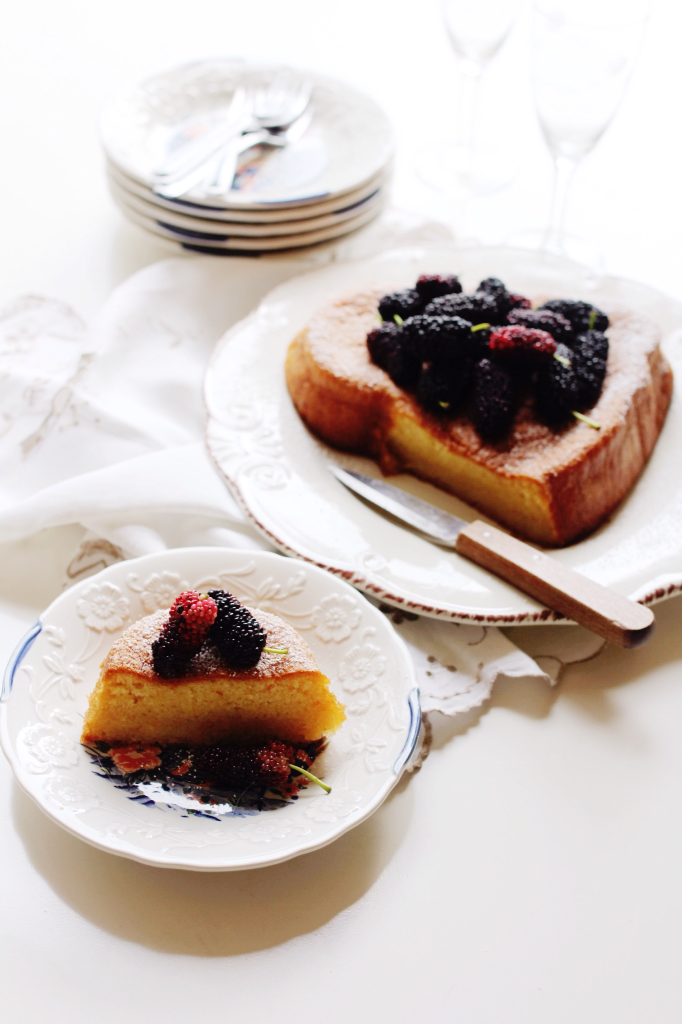"That's it" said Mr K, "I am in Theia Sophia's kitchen" he said taking a bite of a piece of revani and reaching for another. Readers of this blog will know that my husband's favourite cake is revani - or as he calls it, semolina cake. Ever since I found out this little piece of information, I have been on a search to make a wonderful revani that lives up to his childhood memories.
It had been difficult to track down a good recipe - my mother in law and my husbands other aunts (who live in the same street) did not make revani. As Mr K recalled, Theia Katina always makes the most wonderful melamokarona and pumpkin pita - and revani cake is Theia Sophia's speciality. Mr K recalled his aunt bringing big trays of revani down the street to his home for family celebrations and sometimes, just because. This was before his Aunt Sophia and her family moved back to Greece. For Mr K revani is the food of happy memories and good family times.
I had made revani a few times with a couple of different recipes, but none had been quite right. They had always been just a bit too heavy and dense. This time however, I was given a recipe for a light, golden, buttery Zakynthian revani, with an orange/cinnamon honey syrup. The recipe hails from the island which was the birthplace of mother in law and our beloved Aunty Sophia.
The regional cooking differences of Greece never fails to surprise me. Just like Italy, which is known for its regional specialities, Greece's cooking too is ruled by its geography, people and history. There is no one size fits all approach to cooking here. And the recipe for revani cake is no exception - depending on where you come from, it can be quite a different cake. However, this particular recipe certainly hit the mark in terms of food memories for Mr K. "It feels like I am sitting in Theia's kitchen" Mr K said. "After the family returned to Greece, whenever we would visit Theia would always have a big tray of semolina cake waiting for us - it was my favourite. I feel like I am there....it's just Zakynthos."
Zakynthian Revani (Ρεβανί)
Just to add a little bit of a spring touch, I topped my cake with fresh mulberries from the tree in our garden and a very, very light dusting of icing sugar a few minutes before serving.
For the sponge:
6 eggs, separated
6 tablespoons of organic golden caster sugar
Zest of one orange
1 teaspoon of vanilla extract
2 tablespoons of good quality Greek brandy
6 tablespoons of fine semolina
3 tablespoons of self-raising flour
1 teaspoon of baking powder
100 g butter, melted
1/3 teaspoon of bi-carb soda
2 tablespoons of orange juice
For the syrup:
5 tablespoons of honey (or 250g organic golden caster sugar)
1 cinnamon stick
4-5 whole cloves
1 shot of good quality Greek brandy
Method:
Start by making the syrup:
Place the sugar or honey and water in a small saucepan over medium heat. Dissolve the honey or sugar in the hot water, add the cinnamon and cloves, then bring to the boil. Reduce the heat and simmer for about 20 minutes. Add the brandy and let it simmer for a further minute or two, then remove from the heat. Once it has cooled a little, place in the fridge to become very chilled. Before pouring over cakes at step 7, remove the cinnamon and cloves.
For the sponge:
1. Preheat oven to 180°C (160°C fan-forced). Grease and line two 20cm cake tins, ensuring you grease the sides of tin well.
2. Using an electric mixer (or hand whisk if you want a work-out!), beat egg yolks and sugar on a high speed until pale and creamy, about 7 minutes. Then add vanilla, orange zest, brandy and melted butter; beat further another minute, to combine.
3. Dissolve the bi-carb soda in the orange juice and then add to the egg yolk mixture - combine well.
4. Sift semolina, flour and baking powder three times onto a separate bowl. Then gently sift flour mixture, a third at a time evenly over the surface of the egg mixture. Using a large metal spoon, quickly and lightly fold flour each third of mixture through egg yolk mixture until incorporated.
5. In a separate bowl, beat the egg whites to stiff peaks. Then gently fold through the egg yolk and semolina mixture. Divide mixture between two well-greased and lined 20cm cake tins.
6. Place in oven on centre shelf and bake about 30 minutes or until the cakes spring back when touched.
7. Take the cakes out of oven and leave in tins, pierce all over with a skewer (or more authentically a knitting needle). Pour over the chilled syrup over the hot cakes and leave in the tins until all of the syrup is absorbed. Then turn out onto serving plates.






Beautiful! xxx
ReplyDeleteThanks so much Liz xx
DeleteLooks great! My aunt, who's husband was from Zakyntho used to make this for my birthday every year when we were in Greece. One question to clarify: are the measurements for the semolina (6 T) and for the flour (3 T) accurate? They seem very little. :)
ReplyDeleteHow lovely to have this cake for your birthday every year! It's the same in our house now for Mr K's birthday!! Yes, the measurements are 6 level tablespoons of fine semolina and 3 level tablespoons of SR flour. It does seem very small - but the volume really comes from the 6 eggs - particularly the egg whites - make sure they have very stiff peaks before folding in.
DeleteWhat a delightful story and congratulations on winning the revani lottery of recipes! The smile on his face would have been worth all the effort you put in. It's beautiful!
ReplyDelete